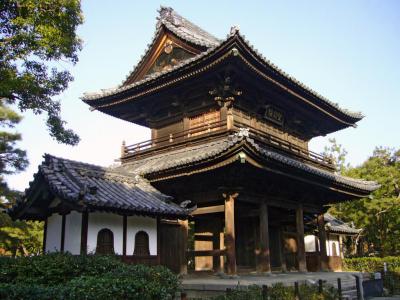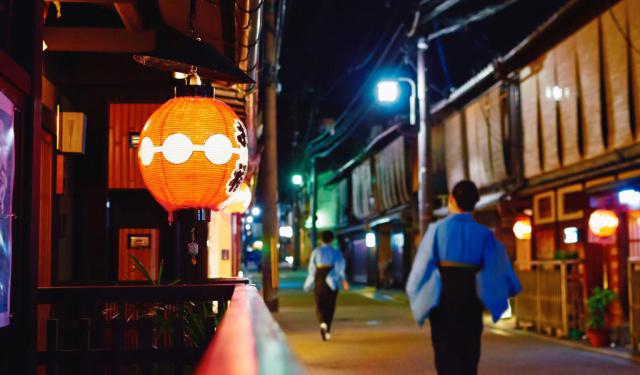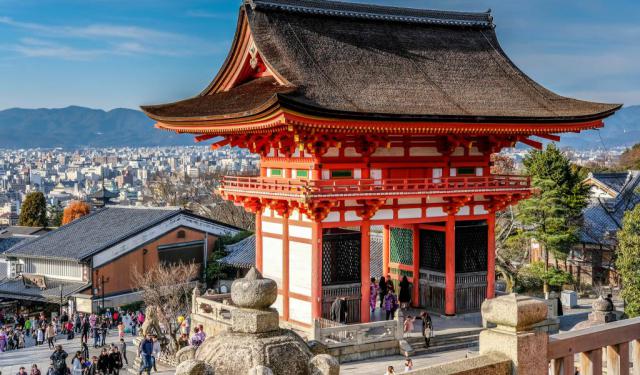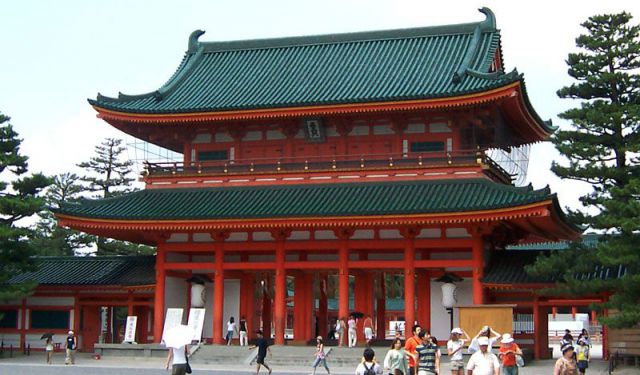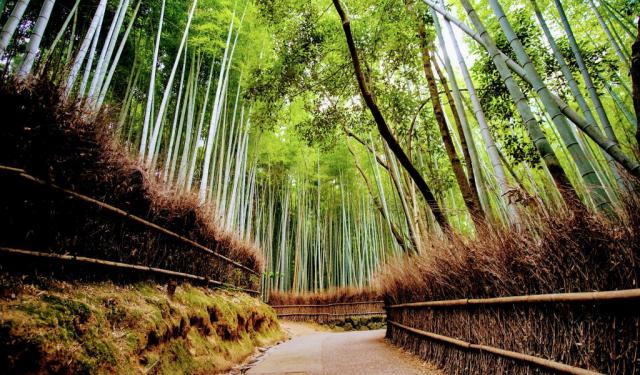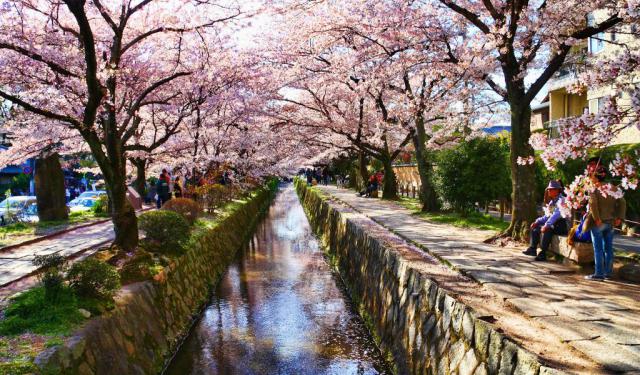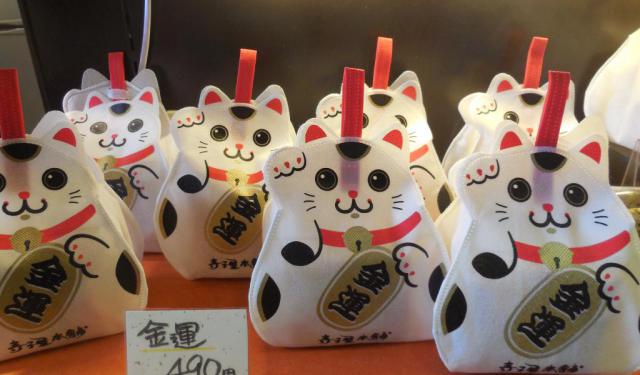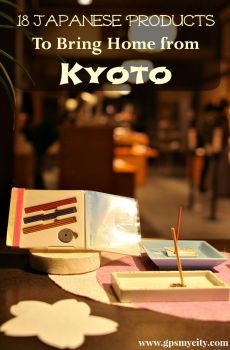Kennin-ji Temple, Kyoto
Kennin-ji might not clinch the title for "Most Jaw-Dropping Zen Monastery" in Kyoto, but it's a goldmine for Japanese art lovers. Conveniently situated in Gion, it's Kyoto's oldest Zen temple-well, kind of. Like many wooden temples in the area, it's had its fair share of fiery mishaps, so the current building is a mere 250 years old. Following a Chinese-inspired setup, the central axis starts from the Messengers Gate in the south, leading through the Sanmon Gate and Lecture Hall to the Abbot's Quarters.
Back in the day, way back in 1202, a monk named Yōsai decided to shake things up and brought back the Rinzai Zen teaching from his adventures in China. And he didn't just bring back Zen, but tea as well, pitching it as a cure-all potion and a handy tool for meditation marathons.
Kennin-ji once was like the Disneyland of Zen, with 53 subtemples spread across its grounds. Nowadays, they're down to 14, but don't let that fool you-this place is still loaded: rock gardens, tea houses, and paintings. Unfortunately, the temple's most prized possession, "The Wind and Thunder Gods" painting, is kept at the Kyoto National Museum, but hey, they've got a good replica to make up for it.
And let's not forget the Lecture Hall, where the ceiling doubles as a canvas for a gigantic dragon mural. Yup, Zen folks believe it's there to keep the bad vibes away and help you find your Zen zone. It's so massive that folks sometimes have to lie flat on their backs just to take it all in. Trust us, it's one of those "pinch-me-I'm-in-Kyoto" moments-you wouldn't want to miss it!
Back in the day, way back in 1202, a monk named Yōsai decided to shake things up and brought back the Rinzai Zen teaching from his adventures in China. And he didn't just bring back Zen, but tea as well, pitching it as a cure-all potion and a handy tool for meditation marathons.
Kennin-ji once was like the Disneyland of Zen, with 53 subtemples spread across its grounds. Nowadays, they're down to 14, but don't let that fool you-this place is still loaded: rock gardens, tea houses, and paintings. Unfortunately, the temple's most prized possession, "The Wind and Thunder Gods" painting, is kept at the Kyoto National Museum, but hey, they've got a good replica to make up for it.
And let's not forget the Lecture Hall, where the ceiling doubles as a canvas for a gigantic dragon mural. Yup, Zen folks believe it's there to keep the bad vibes away and help you find your Zen zone. It's so massive that folks sometimes have to lie flat on their backs just to take it all in. Trust us, it's one of those "pinch-me-I'm-in-Kyoto" moments-you wouldn't want to miss it!
Want to visit this sight? Check out these Self-Guided Walking Tours in Kyoto. Alternatively, you can download the mobile app "GPSmyCity: Walks in 1K+ Cities" from Apple App Store or Google Play Store. The app turns your mobile device to a personal tour guide and it works offline, so no data plan is needed when traveling abroad.
Kennin-ji Temple on Map
Sight Name: Kennin-ji Temple
Sight Location: Kyoto, Japan (See walking tours in Kyoto)
Sight Type: Religious
Guide(s) Containing This Sight:
Sight Location: Kyoto, Japan (See walking tours in Kyoto)
Sight Type: Religious
Guide(s) Containing This Sight:
Walking Tours in Kyoto, Japan
Create Your Own Walk in Kyoto
Creating your own self-guided walk in Kyoto is easy and fun. Choose the city attractions that you want to see and a walk route map will be created just for you. You can even set your hotel as the start point of the walk.
Gion District Walking Tour
Gion, one of Kyoto’s most captivating districts, is deeply rooted in Japan’s cultural heritage. Located in the Higashiyama (the so-called “Eastern Mountain”) neighborhood, its history dates back to the Sengoku period, when it began as a hospitality area for pilgrims visiting Yasaka Shrine. By the late 18th and early 19th centuries, it had evolved into a renowned entertainment quarter,... view more
Tour Duration: 2 Hour(s)
Travel Distance: 2.8 Km or 1.7 Miles
Tour Duration: 2 Hour(s)
Travel Distance: 2.8 Km or 1.7 Miles
Higashiyama Walking Tour
It'd be fair to say that Kyoto is a theme park for lovers of history, religion, and all things deeply, unmistakably Japanese. If so, Higashiyama Ward, with its long lines, can easily be recognized as its star attraction. Tucked along the city’s eastern edge-hence its poetic name translated as “Eastern Mountain”-this district is where Kyoto flaunts its heritage like a geisha in full... view more
Tour Duration: 1 Hour(s)
Travel Distance: 2.6 Km or 1.6 Miles
Tour Duration: 1 Hour(s)
Travel Distance: 2.6 Km or 1.6 Miles
Imperial Kyoto Walking Tour
Kyoto served as Japan’s imperial capital for over 1,000 years, from 794 to 1869, beginning with Emperor Kanmu’s relocation of his court to Heian-kyō (which is Kyoto’s former name). Though political power eventually shifted to the shogunate and later to Tokyo, Kyoto remained the cultural and symbolic heart of Japan. Its long association with the imperial court helped shape it into a refined... view more
Tour Duration: 2 Hour(s)
Travel Distance: 4.1 Km or 2.5 Miles
Tour Duration: 2 Hour(s)
Travel Distance: 4.1 Km or 2.5 Miles
Arashiyama and Bamboo Grove Walking Tour
The Arashiyama district of Kyoto is slightly out of the way for tourists, but that means you can enjoy it more comfortably.
Undoubtedly, the most popular attraction here is the iconic Bamboo Grove, a mesmerizing forest of towering bamboo stalks that sway gently in the breeze, creating an ethereal atmosphere. This serene setting is a must-visit for travelers seeking tranquility amidst... view more
Tour Duration: 2 Hour(s)
Travel Distance: 3.4 Km or 2.1 Miles
Undoubtedly, the most popular attraction here is the iconic Bamboo Grove, a mesmerizing forest of towering bamboo stalks that sway gently in the breeze, creating an ethereal atmosphere. This serene setting is a must-visit for travelers seeking tranquility amidst... view more
Tour Duration: 2 Hour(s)
Travel Distance: 3.4 Km or 2.1 Miles
Walk on Philosopher's Path
Looking for a scenic walk with a side of existential pondering in Kyoto, you're inevitably bound to end up on the Philosopher’s Path. Winding its way for about two kilometers along the leafy canal that carries water from Lake Biwa to the foothills, this picturesque walking trail once served as the thinking route of Nishida Kitaro. Back in the first half of the 20th century, the famed... view more
Tour Duration: 2 Hour(s)
Travel Distance: 2.6 Km or 1.6 Miles
Tour Duration: 2 Hour(s)
Travel Distance: 2.6 Km or 1.6 Miles
Kyoto Shopping and Food Tour
The cultural capital of Japan, Kyoto is just as famous as a shopper’s paradise and, without a doubt, the best place in the country to buy traditional and modern Japanese goods. Souvenirs, food, bargains, and various “one-of-a-kind items” are all up for grabs here.
In addition to its shopping scene, Kyoto boasts a rich culinary heritage, from Michelin-starred restaurants to humble street... view more
Tour Duration: 1 Hour(s)
Travel Distance: 2.0 Km or 1.2 Miles
In addition to its shopping scene, Kyoto boasts a rich culinary heritage, from Michelin-starred restaurants to humble street... view more
Tour Duration: 1 Hour(s)
Travel Distance: 2.0 Km or 1.2 Miles
Useful Travel Guides for Planning Your Trip
18 Japanese Products To Bring Home from Kyoto
The old capital of Japan, the city of Kyoto has once again been the talk of the world lately, thanks to the bestselling "Memoirs of a Geisha" book and the namesake Hollywood blockbuster movie. Renowned for its impeccable craftsmanship, Japan has so much to amaze a foreign eye with. Many of...
